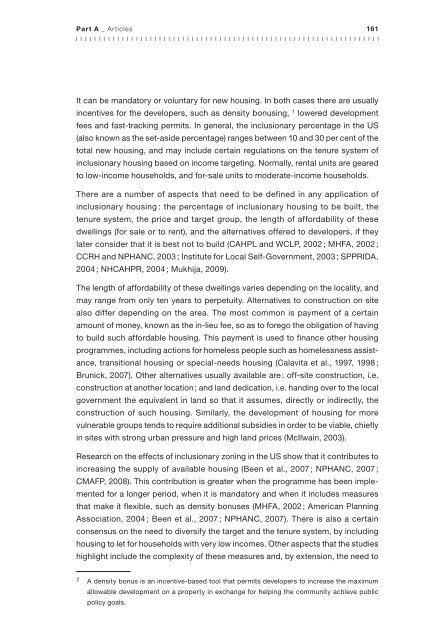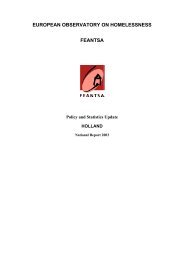Part A - Feantsa - Horus
Part A - Feantsa - Horus
Part A - Feantsa - Horus
Create successful ePaper yourself
Turn your PDF publications into a flip-book with our unique Google optimized e-Paper software.
<strong>Part</strong> A _ Articles<br />
161<br />
It can be mandatory or voluntary for new housing. In both cases there are usually<br />
incentives for the developers, such as density bonusing, 1 lowered development<br />
fees and fast-tracking permits. In general, the inclusionary percentage in the US<br />
(also known as the set-aside percentage) ranges between 10 and 30 per cent of the<br />
total new housing, and may include certain regulations on the tenure system of<br />
inclusionary housing based on income targeting. Normally, rental units are geared<br />
to low-income households, and for-sale units to moderate-income households.<br />
There are a number of aspects that need to be defined in any application of<br />
inclusionary housing : the percentage of inclusionary housing to be built, the<br />
tenure system, the price and target group, the length of affordability of these<br />
dwellings (for sale or to rent), and the alternatives offered to developers, if they<br />
later consider that it is best not to build (CAHPL and WCLP, 2002 ; MHFA, 2002 ;<br />
CCRH and NPHANC, 2003 ; Institute for Local Self-Government, 2003 ; SPPRIDA,<br />
2004 ; NHCAHPR, 2004 ; Mukhija, 2009).<br />
The length of affordability of these dwellings varies depending on the locality, and<br />
may range from only ten years to perpetuity. Alternatives to construction on site<br />
also differ depending on the area. The most common is payment of a certain<br />
amount of money, known as the in-lieu fee, so as to forego the obligation of having<br />
to build such affordable housing. This payment is used to finance other housing<br />
programmes, including actions for homeless people such as homelessness assistance,<br />
transitional housing or special-needs housing (Calavita et al., 1997, 1998 ;<br />
Brunick, 2007). Other alternatives usually available are : off-site construction, i.e.<br />
construction at another location ; and land dedication, i.e. handing over to the local<br />
government the equivalent in land so that it assumes, directly or indirectly, the<br />
construction of such housing. Similarly, the development of housing for more<br />
vulnerable groups tends to require additional subsidies in order to be viable, chiefly<br />
in sites with strong urban pressure and high land prices (McIlwain, 2003).<br />
Research on the effects of inclusionary zoning in the US show that it contributes to<br />
increasing the supply of available housing (Been et al., 2007 ; NPHANC, 2007 ;<br />
CMAFP, 2008). This contribution is greater when the programme has been implemented<br />
for a longer period, when it is mandatory and when it includes measures<br />
that make it flexible, such as density bonuses (MHFA, 2002 ; American Planning<br />
Association, 2004 ; Been et al., 2007 ; NPHANC, 2007). There is also a certain<br />
consensus on the need to diversify the target and the tenure system, by including<br />
housing to let for households with very low incomes. Other aspects that the studies<br />
highlight include the complexity of these measures and, by extension, the need to<br />
1 A density bonus is an incentive-based tool that permits developers to increase the maximum<br />
allowable development on a property in exchange for helping the community achieve public<br />
policy goals.




